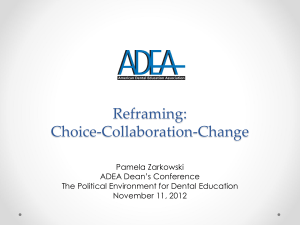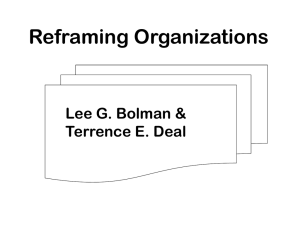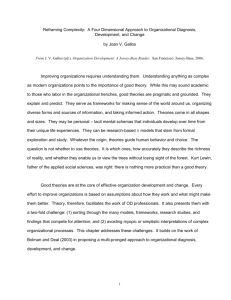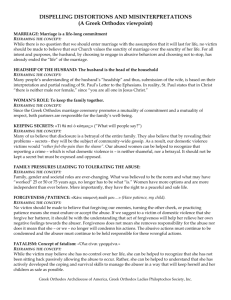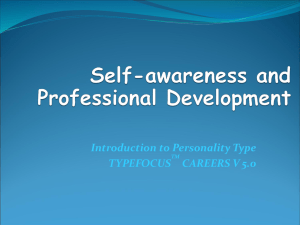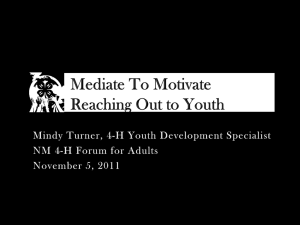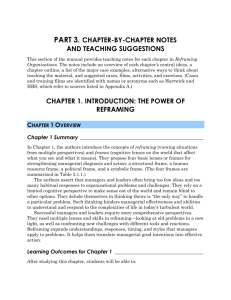Reframing Organizations
advertisement
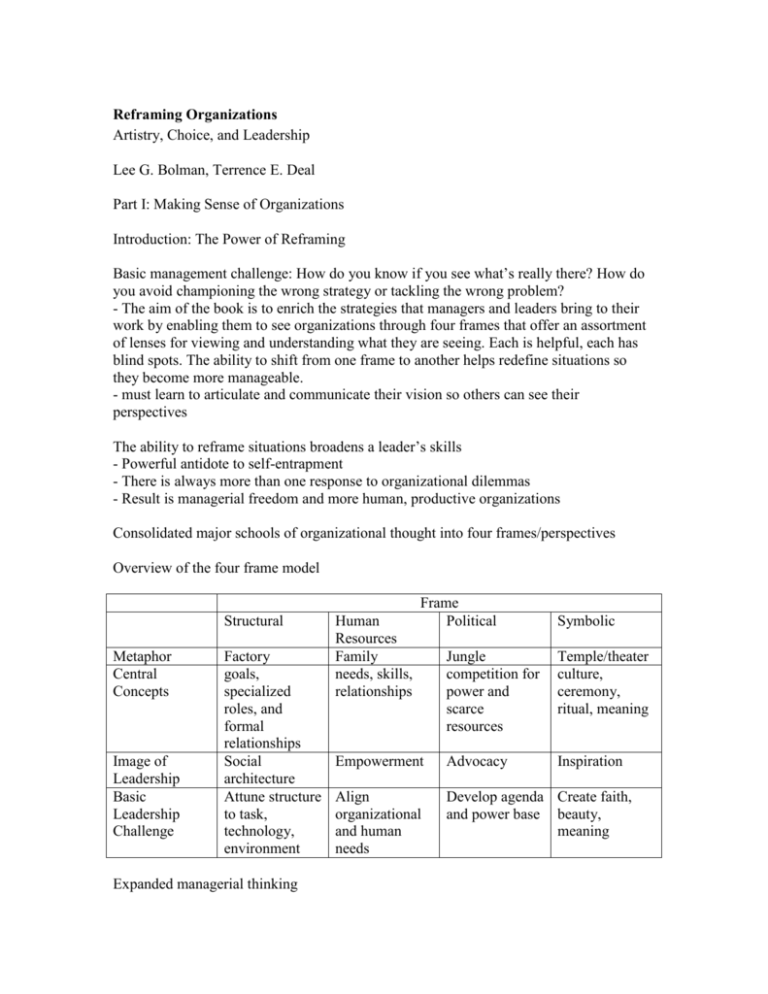
Reframing Organizations Artistry, Choice, and Leadership Lee G. Bolman, Terrence E. Deal Part I: Making Sense of Organizations Introduction: The Power of Reframing Basic management challenge: How do you know if you see what’s really there? How do you avoid championing the wrong strategy or tackling the wrong problem? - The aim of the book is to enrich the strategies that managers and leaders bring to their work by enabling them to see organizations through four frames that offer an assortment of lenses for viewing and understanding what they are seeing. Each is helpful, each has blind spots. The ability to shift from one frame to another helps redefine situations so they become more manageable. - must learn to articulate and communicate their vision so others can see their perspectives The ability to reframe situations broadens a leader’s skills - Powerful antidote to self-entrapment - There is always more than one response to organizational dilemmas - Result is managerial freedom and more human, productive organizations Consolidated major schools of organizational thought into four frames/perspectives Overview of the four frame model Structural Metaphor Central Concepts Image of Leadership Basic Leadership Challenge Factory goals, specialized roles, and formal relationships Social architecture Attune structure to task, technology, environment Expanded managerial thinking Human Resources Family needs, skills, relationships Frame Political Symbolic Jungle competition for power and scarce resources Temple/theater culture, ceremony, ritual, meaning Empowerment Advocacy Inspiration Align organizational and human needs Develop agenda Create faith, and power base beauty, meaning Expanded managerial thinking How managers think How managers might think Limited view of organizations Holistic framework that encourages inquiry into a range of significant issues: people, processes, power, symbols Regardless of a problem’s source, often Use a palette that offers a range of options: choose rational and structural solutions: bargaining, training, celebration, facts, logic, restructuring reorganization Value certainty, rationality, and control. Develop creativity, risk taking, and Fear ambiguity and going with the flow. playfulness. Focus as much on finding the right question as the right answer, finding meaning and faith amid chaos and confusion Rely on the one best answer or right way, Passionate, unwavering commitment to being stunned at the turmoil and resistance principle, combined with flexibility in it generates understanding and responding to events Chapter 2 Simple Ideas, Complex Organizations The first step in managerial wisdom and artistry is to understand the situation you face. Properties of Organizations - Organizations are complex o bewildering array of people, departments, technologies, goals, and environments - Organizations are surprising o Some interactions and consequences are hard to predict - Organizations are deceptive o They defy expectations and camouflage surprises o Communications in organizations are seldom candid, open, or timely - Organizations are ambiguous o Complexity, unpredictability, and deception add up to a lot of ambiguity o Sources of ambiguity We are not sure what the problem is We are not sure what is really happening We are not sure what we want We do not have the resources we need We are not sure who is supposed to do what We are not sure how to get what we want We are not sure how to determine if we have succeeded Organizational Learning - We learn best from experience, but often do not directly experience the consequences of our decisions (in large organizations) Cause and effect often widely separated (need to understand the whole system and how its parts interact, not just the pieces) We sometimes try to solve problems without discussing the un-discussable or run afoul of organizational taboos Coping with Ambiguity and Complexity - - People’s perspectives determine what they “see” o One’s internal world is as important as what is outside Managers face an unending series of problems, but they must take the time to probe more deeply to pinpoint what is really going on Theories help us do two thinks o Tell us what is important and what can be safely ignored o Group many different bits of information into patterns or concepts There are many ways individuals interpret reality to protect their own belief systems Managers often use interactions with others not to gain new information but to strengthen the justification for their current thinking Common Fallacies in Organizational Diagnosis - - - Three approaches based on partial truth o People blaming approach: explains everything in terms of individual characteristics o Blame the bureaucracy o Thirst for power The four organizational frames offer a pluralistic approach o An assortment of lenses for viewing the organization o Each is helpful, each has blind spots o The ability to shift from one frame to another helps redefine situations so they become more manageable For managers with better theories and the capacity to use their theories with skill and grace, the world is full of excitement and possibility Part 2: The Structural Frame Ch 3 Getting Organized The structural frame looks beyond individuals to examine the social context of work - When structure is overlooked, organizations often misdirect energy and resources Dimension Size and Age Structural Implications Complexity and formalization increase with size and age Core process Environment Information technology Strategy and goals Nature of workforce Core processes or technologies must align with structure Stable environments reward simpler structures; uncertain, turbulent environments require more complex, adaptable structure Information technology permits flatter, more flexible, more decentralized structure Variations in clarity and consistency of goals require appropriate structural adaptations (think Harvard vs. McDonalds) More educated and professional workers need and want greater autonomy and discretion The right structure depends on an organization’s goals, strategy, technology, and environment - There is no one best way to organize - Structural form both enhances and constrains what organizations can accomplish Structuring and Reengineering Enduring Structural dilemmas: tough trade-offs with no easy answers. * Differentiation versus Integration * Gaps versus Overlaps * Under use versus Overload * Lack of Clarity versus Lack of Creativity * Excessive Autonomy versus Excessive Independence * Too loose versus too Tight * Diffuse Authority versus Over centralization * Goalless versus goal bound * Irresponsible versus Unresponsive Achieving the right balance is tied closely to an organization’s total situation: current environment, workforce, technology, and past structural commitments. Mintzberg differentiates five major components in organizational structure: * the strategic apex: focus on outside environment, mission and grand design, * the middle management: supervise, control, provide resources, * the operating core: people who perform the basic work to produce the product/service, * the techno structure: specialists and analysts who standardize, measure, inspect outputs and processes, and * the support staff: perform tasks that support the work of others. Different configurations of these components lead to different organizational forms: simple structure, machine bureaucracy, professional bureaucracy, divisionalized form, and adhocracy. Pressures that lead to restructuring include: * environment shifts * technology changes * organizations grow * leadership changes Basic principles of successful structural change: * develop new conception of goals and strategies * careful study of existing structure/process to know how things work * design new structure in view of changes goals, technology, and environment * experiment: retain what works, discard what does not Organizing Groups and Teams Team work represents a set of values that encourages listening and responding to views expressed by others, giving each other the benefit of the doubt, providing support, and recognizing the interests and achievements of others. Many classic team problems arise from ill-fitting structures. [High performing commando unit] In dealing with tasks, groups have a number of structural options. The one they choose or the one that evolves- must allow members to pool individual contributions successfully without creating pathologies that often plague small groups. * requires careful consideration of situational variables - What are we trying to accomplish? - What needs to be done? - Who should do what? - How should we make decisions? - Who is in charge? - How do we coordinate the efforts? - What do individual members care about most- time, quality, and participation? - What are the special skills and talents of each group member? - What is the relationship between this group and others? - How will we determine success? Distinguishing characteristics of high performing teams: * Top managers provide clarity of charter/rationale and the challenge, but provide flexibility for the team to work out specific goals and plane of operation. * Translate common purpose into specific, measurable performance goals. * Manageable size (2-25) * Develop the right mix of expertise * Common commitment to working relationships (who does what, schedules, skills needed/developed, how membership earned, how to make and modify decisions * Team members hold themselves collectively accountable The Human Resource Frame People and Organizations Ch 8 Interpersonal and Group Dynamics - Interpersonal Dynamics * Three recurrent questions regularly haunt managers: + What is really happening in this relationship? + Why do other people behave as they do? + What can I do about it? * Argyris emphasizes the importance of "interpersonal competence" as a basic managerial skill. He showed that managers' effectiveness was often impaired because they were over controlling, excessively competitive, uncomfortable with feelings, closed to others' ideas, and blind to their own impact. * Argyris and Schon found significant discrepancies between espoused theories and theories-in-use. Managers' talk is often unconnected to their actions. They typically see themselves as rational, open, concerned for others, and democratic, not realizing that their actions are competitive, controlling, and defensive. Such blindness is pervasive because most managers employ a self-protective model of interpersonal behavior, particularly in dealing with issues that are embarrassing or threatening. Argyris and Schon refer to this theory-in-use as Model 1. Model I Theory-in-Use Core Values (governing variables) Define and achieve your goals Action Strategies Consequences of the Consequences for Behavioral World Learning Design and manage the environment unilaterally You will be seen as defensive, inconsistent, fearful, selfish Maximize winning, minimize losing Own and control whatever is relevant to your interests You create defensiveness in interpersonal relationships Minimize Unilaterally protect You reinforce You seal yourself off (so you will not know about the negative consequences of your actions) You get caught up in single-loop learning (you do not question your core values and assumptions) You test your generating or expressing negative feelings yourself (from criticism, discomfort, vulnerability, etc) Be rational Unilaterally protect others from being upset or hurt (censor bad news, hold private meetings, etc.) defensive norms (mistrust, risk avoidance, conformity, rivalry, etc.) Key issues become undiscussable assumptions and beliefs privately, not publicly You engage in unconscious collusion to protect yourself and others from learning * Lurking in Model I is the core assumption that organizations are competitive, dangerous places where you have to look out for yourself or someone else will do you in. That assumption leads individuals to follow a predictable set of steps in their attempts to influence others. + Assume the problem is caused by the other person(s). + Develop private, unilateral diagnosis and solution + Since the other person is the cause of the problem, get that person to change, using one or more of three basic strategies: x facts, logic, and rational persuasion (argue the merits of your point of view) x indirect influence (ease in, ask leading questions, manipulate the other person) x direct critique (tell the person what they are doing wrong and how they should change) + If the other person resists or becomes defensive, it confirms that the other person caused the problem. + Respond to resistance through some combination of intensifying pressure and protecting or rejecting the other person. + If your efforts are unsuccessful or less successful than hoped, it is the other person's fault. You need feel no personal responsibility. * The result is wasted energy, strained relationships, and deterioration in decision-making processes-all predictable consequences of Model I. * Agyris and Schon propose Model II as an alternative: + Emphasize common goals and mutual influence. + Communicate openly, and publicly test assumptions and beliefs. + Combine advocacy with inquiry x Advocacy includes statements that communicate what an individual thinks, knows, wants, or feels. Inquiry seeks to learn what others think, know, want, or feel. Inquiry High Low Assertive High Integrative Low Passive Accommodative Advocacy *When managers feel vulnerable, they revert to self-protection. They skirt issues or attack others and escalate games of camouflage and deception. Feeling inadequate, the camouflage their inadequacy. To avoid detection, they pile subterfuge on top of camouflage. This generates even more uncertainty and ambiguity and makes it difficult or impossible to detect errors. As a result, organizations often persist in following a course everyone privately thinks is a path to disaster. No one wants to be the one to speak the truth. * The result is often catastrophe. In a number of well-documented aviation accidents, the copilot believe that the captain was making a serious mistake yet chose not to say so directly. Instead, he used vague questions to nudge the captain gently. In each case, the captain missed the message. Perhaps the copilots feared upsetting their commander (who was an overcontrolling jerk in several instances). Perhaps they were not sure the captain was wrong. In any event, the errors were fatal. More direct communication could not have made things any worse and might have saved the airplane, passengers, and crew. Structural goals specialized roles formal relationships division of labor rules, policies, procedures, and hierarchies Problems arise when structure does not fit situation Human Resources extended family feelings, prejudices, skills, and limitations tailor org to people Political arenas contests jungles interests compete for limited resources conflict is rampant bargaining, negotiation, coercion, and compromise Problems arise when power is concentrated in wrong place or when so broadly dispersed nothing gets done. Symbolic cultural and social anthropology tribes, theater, or carnivals cultures on rituals, ceremonies, stories, heroes, myths org is actors Integrating the Four Frames Multiframe thinking requires movement beyond narrow mechanical thinking. See Overview Table of Four Frames Overview of Four-Frame Model Structural Metaphor for Organization Central Concepts Factory or machine Rules, roles, goals, policies, technology, environment Image of Leadership Basic Leadership Challenge Social architecture Attune structure to task, technology, environment Human Resources Family Political Symbolic Jungle needs, skills, relationships Power, conflict, competition, organizational politics Empowerment Advocacy Carnival, temple, theater Culture, meaning, metaphor, ritual, ceremony, stories, heroes Inspiration Align org and human needs Develop an agenda Create faith, and power base beauty, meaning Source: Bolman and Deal; Reframing Organizations; 1997; Table 1.1, page 15 Structural Frame Specialized tasks, sequential work, close supervision, top down. increase efficiency through specialization & division of labor 1. How to allocate work knowledge or skill time product customers or clients geography process 2. How to coordinate different roles Combining vertical and lateral power. As a group, the org decides course of action, this is lateral or horizontal decision making. Once all agree, consensus, then the leader can act in vertical fashion because all have had a stake in its creation. Problems arise in top down situations. Imperatives Pressures Zebra pages 77 & 332 one boss is top down dual authority task oriented Simple hierarchy is layers Circle borders on "web inclusion" All-channel network is the web. Star within the circle. Human Resources Frame McGregor of MIT helped develop ideas. "Open system," communication of good and bad news, self-managing teams, peer-controlled pay system. This frame regards people's skills, attitudes, energy, commitment. This frame champions idea that orgs can be stimulating, rewarding, and productive. If org concerns itself with it's people's welfare then it will succeed. Physiological (oxygen, water, food, comfort) Safety (safe from attack) Belongingness and Love Esteem (to feel value of self) Self-actualization (to reach one's potential) ome self-fulfilling prophecies. If you have low expectations you will get low productivity. Conflict If conflicts arise people tend to: mb hierarchy to better jobs Improving HR Management cared for his workers by giving clean safe homes. Preschool, child care, and schools. He knew value of human capital. Hire right Reward well Provide job security Promote from within Train and Educate Dewey: Learn by doing OJT Share the wealth Autonomy and Participation Job Enrichment and Cross-Utilization Teaming Democracy and Egalitarianism -Groups: "sensitivity training," participants and researchers quorum after session to discuss observations. Trainers and participants join in groups as a sort of "plenary." Honest feedback is crucial. -groups, and Surveys. Putting it in Action personal Dynamics What is happening? Why do people behave as they do? What can I do? problem caused by other people develop private, unilateral diagnose and solution get other person to change by logic, influence, force if other resists become defensive intensify pressure Result is wasted energy, strained relationship, deterioration in decision-making processes. Emphasize common goals & mutual influence Communicate openly publicly test assumptions Combine Advocacy with Inquiry -protection. Personality Tests Meyers-Briggs Barbarian's Online Test Page creates informal roles with so many formal roles around informal rules evolve develop listening skills agree on basics search for commonness Experiment Doubt your infallibility differences of personalities are a groups responsiblity Political Frame Sees orgs as alive screaming arenas. Political Frame appears to be primary determinant of success in certain jobs. p 278 Focus of the political Frame is not on resolution of conflict, but on strategy and tactics. PF Insists Orgs are Coalitions result can be confusing with multiplicity of goals many in conflict Power one power liances and networks Conflict status quo Summary be "constructive" politicians. Skills of Political Manager sets goals and schedules statements of interests and direction provide a vision and strategy for achieving vision provide direction while tending to needs of stakeholders while gathering plant too. a vision without a strategy is an illusion not automatic find order amid chaos move with speed and focus know where explosives are channels of informal communications id principal agents of influence possibility of internal and external mobilization anticipate strategies of others draw it up on paper Id relevant relationships Assess who might resist, why and how strongly develop relationships with opponents to facilitate communications When 3 fails be forceful or subtle No strategy will work without power base Find friends, cheerleaders "horse trading", negotiating bargaining is central to decision making Creating Value vs Claiming Value Creative = be inventive and cooperative for win-win Claiming = be forceful, to achieve win-lose Positional bargaining means you start at a place and give concessions Principled bargaining: emphasizes creating not claiming 1. separate people from problem 2. focus on interests, not positions 3. invent options for mutual gain 4. insist on objective criteria: standards of fairness Morality tell them your vision state your best understanding of their position Id your own contribution What you plan to do following rules that are understood and accepted? comfortable discussing and defending your action? Would you want someone to do it to you? What if everyone acted that way? Are there more ethical ways? Mutuality Generality Caring Arenas -Up Pol action Unions civil rights movement Central admin institutes Workers are surprised, not in process Agents Symbolic Frame Organizations reek of symbolism from the edifices they work in to their mascots, colors, and products. That some company names have become words, i.e. Xerox, scotch tape, coke, attest to the power of symbolism. not what happened but what it means d stories. mystery myths, fairy tales, stories provide explanations rituals and ceremonies give heritage Metaphor, humor, and play loosen up and provide depth to situation. opportunities. Myths are not authority. They can keep us sane. All orgs rely on myths or sagas. Myths create internal cohesion, sense of direction, confidence. order, clarity, and predictability. Intiate newcomers. special events. , & PLAY show "as if" quality of symbols. Metaphor: Cook says he is a professional, an artist, a business person and a worker. Humor allows for loosening of tension. org without a plan is rudderless, short-sighted, and reactive. Plans are symbols Plans become games Plans become excuses for interaction Plans become advertisements ymbolizes success or failure. Leading Principles done by ritual, applying, interviewing etc edge portionately to Formal Roles Integrating Frames Four Interpretations of Organizational Processes Process Strategic Planning Decision Making Reorganizing Structural Strategies to set objectives and coordinate resources Human Resources Gathering to promote participation Political Arenas to air conflicts and realign power Symbolic Ritual to signal responsibility, produce symbols, negotiate meanings Rational Open process to Opportunity to Ritual to confirm sequence to produce gain or exercise values and produce right commitment power provide decision opportunities for bonding Realign roles and Maintain balance Redistribute Maintain image of responsibilities between human power and form accountability and to fit tasks and needs and formal new coalitions responsiveness; environment roles negotiate new social order Process Evaluating Approaching conflict Goal Setting Structural Way to distribute rewards or penalties and control performance Maintain organizational goals by having authorities resolve conflict Keep organization headed in right direction Human Resources Political Symbolic Process for Opportunity to Occasion to play helping exercise power roles in shared individuals grow ritual and improve Develop relationships by having individuals confront conflict Keep people involved and communication open Human Process Structural Resources Communication Transmit facts Exchange and information information, needs, and feelings Meetings Formal occasions Informal for making occasions for decisions involvement, sharing feelings Motivation Economic Growth and selfincentives actualization Process Structural Human Resources Develop power by bargaining, forcing, or manipulating others to win Provide opportunity for individuals and groups to make interests known Develop shared values and use conflict to negotiate meaning Political Influence or manipulate others Symbolic Tell Stories Competitive occasions to win points Sacred occasions to celebrate and transform the culture Symbols and celebration Coercion, manipulation, and seduction Political Develop symbols and shared values Symbolic Source: Reframing Organizations; Bolman and Deal; 1997; Table 15.1, pages 267-8 Hypertext Choosing A Frame of Choosing A Frame Press BACK to return from whence you came. Question Are individual commitment and motivation essential to success? Is the technical quality of the decision important? Are there high levels of ambiguity and uncertainty? Are conflict and scarce resources significant? Are you working from the bottom up? Frame if Answer is Frame if Answer is No Yes Human Resource, Structural, Political Symbolic Structural Human Resources, Political, Symbolic Political, Symbolic Structural, Human Resources Political, Symbolic Structural, Human Resources Political Structural, Human Resources, Symbolic Source: Bolman and Deal; Reframing Organizations; 1997; Table 15.2, page 271 Reframing in Action Essence of reframing is examining the same situation from multiple vantage points to develop holistic picture. Each Frame provides advantages, but also blind spots. Does this mean schools should be concerned with things in the home etc? Reliance on structure negates other frames influence. looking for growth and collaboration. nicism and mistrust. Often misunderstood to be amoral, scheming, and unconcerned about the common good. camouflage Pages 282-293 provide a great look at how to utilize the frames in action. Cindy Marshall in new position and how she could handle given situations to her advantage/disadvantage. Leadership engaged parties. eaders to persuade or inspire not coerce subtle process of mutual influence fusing thought, feeling, and action to produce cooperative effort in the service of purposes and values of both the leader and the led. work well, inspire trust and build relationships, honesty. Reframing Leadership Reframing Leadership of Reframing Leadership Frame Structural Human Resources Political Symbolic Effective Leadership Leader Leadership Process Analyst, Analysis, design architect Catalyst, Support, servant empowerment Advocate, Advocacy, coalition negotiator building Prophet, poet Inspiration, framing experience Ineffective Leadership Leader Leadership Process Petty Tyrant Management by detail and fiat Weakling, Abdication pushover Con artist, Manipulation, fraud thug Fanatic, fool Mirage, smoke, and mirrors Source: Bolman and Deal; Reframing Organizations; 1997; Table 17.1, page 303 do their homework rethink the relationship of structure, strategy, and environment focus on implementation experiment, evaluate, adapt believe in people and communicate their belief visible and accessible empower others clarify what they want and what they can get assess the distribution of power and interests build linkages to key stakeholders persuade first, negotiate second, coerce when necessary use symbols to capture attention frame experience discover and communicate vision tell stories, See Gettysburg Address Reframing Change turbulent middle, and a discouraging ending Reframing esp. when new technology comes in terans become neophytes predictability, and security. -sitters status quo prevails and change agents lose Arenas provide rules, referees, and spectators arenas Soul ove Chapter 20 pages 354-376 provides a great scenario of using the Frames in action. New Principal walks into problems and uses frames to solve them.
